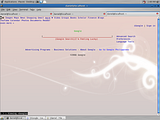Enter the world of text browsing. I'm not here to discuss the history of browsing. That task is best left to the historians and experts. What I am here to discuss is text browsing and how it can be done today on our GNU/Linux PC specifically through the terminal.
Several software come to mind when we speak of text browsers but I would choose only one: w3m.

Browsing Google on the Terminal with w3m
w3m is a text-based web browser as well as a pager like `more' or `less'. With w3m you can browse web pages through a terminal emulator window (xterm, rxvt or something like that). Moreover, w3m can be used as a text formatting tool which typesets HTML into plain text.
w3m Home
To install w3m on your Debian system, just do this:
$ sudo apt-get install w3m
To browse the interwebs simply do:
$ w3m www.google.com
TIPS:
1. TAB is a useful key and so is enter
2. To go back, press ESC + Down Arrowkey
3. To search something over at Google,
- Use the arrow keys to get over the blank space and press the ENTER key
- Then type the search term and press the ENTER key
- TAB over to the text equivalent of the 'Search Google' button
- You can download stuff from the Internet by pressing ENTER on the link text (usually blue)
This is useful! Especially for slow connections. For me the most importaint is to browse without corrupting the RAM - Opera & Firefox take too much of ram memory, and they're slow with browsing all that fancy stuff. This is perfect for your eye isn't bothered by stupid blinking commercials etc.
ReplyDeleteIf one wants youtube or photos, it's also possible to pull it from w3m and view it in external viewers.
By the way, you don't need to install it - ubuntu 8.04 has it, and I'm sure that other new distros have it too.
I appreciate the positive comment. Thanks for the info. :)
ReplyDeleteHi!
ReplyDeleteI'm posting this using the nano editor through w3m on my ubuntu system!
This is a really great way to browse the web in terminal.
I hope this worked.
-redrvm
really cool..thanks a lot...i learn a lot here....
ReplyDeleteThis comment has been removed by the author.
ReplyDelete